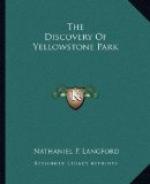As we passed along the shore to-day, we could see the steam rising from a large group of hot springs on the opposite shore of the lake bordering on what seems to be the most westerly bay or estuary.[M] We will have an opportunity to examine them at short range, when we have completed our journey around the lake.
Tuesday, September 6.—We broke camp at ten thirty this morning, bearing well to the southeast for an hour and then turning nearly due south, our trail running through the woods, and for a large part of our route throughout the day, through fallen timber, which greatly impeded our progress. We did not make over ten miles in our day’s travel. Frequently we were obliged to leave the trail running through the woods, and return to the lake, and follow the beach for some distance. We passed along the base of a brimstone basin, the mountains forming a semi-circle half way around it, the lake completing the circle. In company with Lieutenant Doane I went up the side of the mountain, which for the distance of three or four miles and about half way to the summit is covered with what appears to be sulphate (?) of lime and flowers of sulphur mixed. Exhalations are rising from all parts of the ground at times, the odor of brimstone being quite strong; but the volcanic action in this vicinity is evidently decreasing.
About half way up the deposit on the mountain side a number of small rivulets take their rise, having sulphur in solution, and farther down the mountain and near the base are the dry beds of several streams from ten to twenty feet in width which bear evidence of having at some time been full to the banks (two or three feet deep) with sulphur water. The small streams now running are warm.
The side of the mountain over which we rode, seems for the most part to be hollow, giving forth a rumbling sound beneath the feet, as we rode upon the crust, which is very strong. In no instance did it give way as did the crust at “Crater hill,” under which the fires were raging, though the incrustation appears to be very similar, abounding in vents and fissures and emitting suffocating exhalations of sulphur vapor.
On the sides of the mountain were old fissures, surrounded by rusty looking sulphur incrustations, now nearly washed away. The whole mountain gives evidence of having been, a long time ago, in just the same condition of conflagration as that in which we found “Crater hill;” but all outward trace of fire has now disappeared, save what is found in the warm water of the small streams running down the sides.
Our course for the past two days has been in nearly a south-southeast direction, or about parallel with the Wind river mountains. We have to-day seen an abundance of the tracks of elk and bears, and occasionally the track of a mountain lion.




